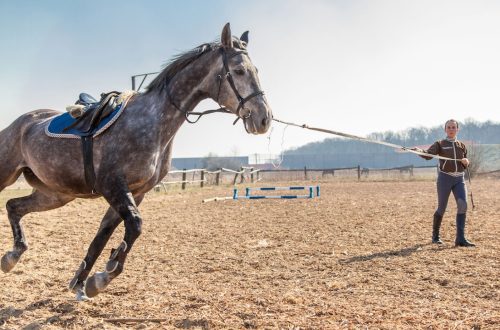
Work in hand
Hand work is recommended especially with horses that are difficult to ride or lack physical development. At the same time, “hot” or too receptive horses calm down and become “tame” in the full sense of the word, while lazy ones, on the contrary, become livelier. The method of work “in the hands” has been known for a very long time, but, unfortunately, our coaches do not use it much, and often ignore it. Meanwhile, the French and German dressage masters use the work “in the hands” very widely.
From the experience of coaches in Germany
Work “in the hands” is recommended to start only when the horse is not excited and feels at ease. The horse must be placed near the wall, the rider stands on the inside at its head (Fig. 1). In the left hand (when riding to the left) the rider has the reins, in the right – a whip. Both the rein and the whip should be easy to work with. Retreating along the wall of the arena, the rider encourages the horse to follow him with his voice and pulling on the reins. The hand that holds the reins should, as it were, be ahead of the “mouth” of the horse. Only after the horse has begun to move forward confidently from the light touch of the whip (this is achieved in a few days), you can start the real work.
The tip of the whip can be touched directly behind the girth to the thigh and metatarsus of the back inside leg. Both the rein and the whip must be worked very softly.
If the horse works willingly, it is necessary to encourage it with your voice, stroke it, this allows you to educate a horse that, even from the lightest message, energetically moves forward.
For successful work “in the hands” of great importance is the correspondence between expelling and deterrent means. The forward message must prevail. Work at first in a free, then in a collected walk, then move on to a shortened trot if possible.
When the means of influence are too hard, or when the rider forcibly tries to collect the horse, he makes a “candle”. Rising on its hind legs, the horse tries to free itself from the constant compulsion for it. From this bad manner, the horse must be immediately weaned, because it can become a habit. The rider must also grab the chin strap with the hand holding the reins, so that the horse has to lift the rider along with his forehand. This is hard and the horse will quickly refuse to “glow”.
From the experience of French coaches
The French classical school of dressage recommends the widespread use of work “in the hands” as a technique that provides a gradual increase in the cognitive load on the horse from the known to the unknown. As the French authorities emphasize, work “in the hands” should precede similar exercises carried out under the rider, since it is especially important for a young horse to have the muscles of the back released from the load in the first lessons.
Before starting work “in the hands”, the horse is kneaded on the cord (possible with elastic interchanges).
The trainer for several minutes repeats “in the hands” the exercises with which the horse was introduced in previous lessons, and then proceeds to learn new ones. Handwork repetitions should be short: 10 minutes, after 20 minutes of lunging and before work in the saddle, and 5 to 10 minutes at the end of the session.
 Horseman1 19 March 2011 city
Horseman1 19 March 2011 cityAnd this article is about work in hand? Mda-ah-ah-ah … Answer
- Sasha09 16 2012 of August
Not much information, but it’s useful too Answer
 Nikole 14 April 2014 city
Nikole 14 April 2014 cityA very useful article for a person who is just getting acquainted with the work in his hands. If a person already has an idea about such work, then of course there is not enough information here. Answer





